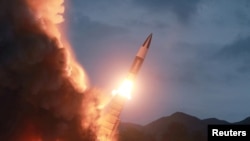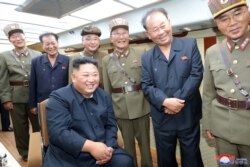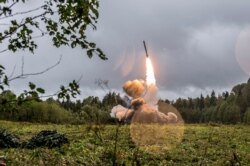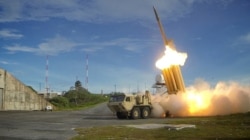Christy Lee and Kim Young-gyo contributed to this report which originated on VOA’s Korean Service.
WASHINGTON — The recent missile tests by North Korea, including one Saturday, show potential weapons that are designed to circumvent any preemptive strikes that would destroy them on their launch pads before being fired, experts said.
North Korea wants to “be able to roll out a launcher, fire immediately, and not give the U.S. and South Korea an opportunity to attack the launcher and destroy them before they can launch their missiles,” said Bruce Bennett, a senior defense and analyst at the Rand Corp.
North Korea said Sunday it tested “another new weapons system” with an “advantageous tactical character different [than] the existing weapons systems” through the official Korean Central News Agency (KCNA).
The statement came the day after North Korea tested two missiles, which South Korean officials described as short-range missiles. Saturday’s test is North Korea’s fifth launch in less than a month.
On Tuesday, Andrea Thompson, undersecretary for Arms Control and International Security at the State Department, said, “We will continue to call out [North Korea] on their missile testing,” expressing concern over the new type of missiles North Korea said it tested.
What kind of missile is it?
According to experts, the latest missiles North Korea launched are similar to the KN-23, which has specifications comparable to the Russian-made Iskander type missile that Pyongyang began testing in May.
“It looks like it is the same diameter as the KN-23, the Iskander look-alike [but] is shorter,” said Jonathan McDowell, an astrophysicist at the Harvard-Smithsonian Center for Astrophysics. “It is probably in the same family as the KN-12 Iskander-ish missile but with a slightly different role. It is certainly unclear what its role is right now.”
North Korea first tested what are considered KN-23 missiles May 4 and again May 9, calling them “tactical guided weapons.” North Korea first unveiled the then-unnamed solid fuel, short-range missile in 2018 during a February parade to honor the 70th anniversary of the Korean People’s Army. After the two launches in May 2019, the U.S. dubbed the Iskander-like missile, the KN-23.
The missiles North Korea tested July 25, which it again called “tactical guided weapons,” and Aug. 6 are also considered the KN-23, according to Bennett.
Not a new missile
Bruce Bechtol, a former intelligence officer at the Defense Intelligence Agency and now a professor at Angelo State University in Texas, said although North Korea is calling the missiles “new,” they are similar to the missiles modeled after the Iskander.
“People may have been misinterpreting the North Korean statements,” Bechtol said. The statements may have been referring to missiles that are new this summer, he added. “The Iskander is new. They just started testing it. They may have been referring to the same missile.”
McDowell said if the missiles tested Saturday are the KN-23 model, they are “using the similar or the same solid motor” referring to the use of solid-fuel propelled engines in the missiles.
“Solid propellant missiles are easier to deploy operationally than liquid propellant ones because you don’t have to fuel them up,” McDowell said. “They are just ready to go.”
Missiles using solid fuel, Bennett said, can be launched “without having to refuel them after they set them up” on a launch pad. However, the missiles using liquid fuel have to be “set up and then refueled,” and the refueling process “could take half an hour or more, making it vulnerable to a preemptive attack,” according to Bennett.
“If they fuel [the missile], you [have] warning that it [was] potentially going to be launched, and so that was a good time to preempt,” Bennett said.
Launch pads and types of missiles
A preemptive strike is aimed at an enemy’s capabilities before they are launched, depriving it of its ability to attack.
Bennett said, however, North Korea may not have enough launch pads to fire multiple missiles simultaneously.
“If they continue making many more missiles than they make launchers, then a whole bunch of those missiles are sitting somewhere at the time of the first launch,” he said. “Do they also have sufficient launchers to disperse all of the missiles simultaneously? Or do they still have six or eight or 10 missiles per launchers so that a bunch of them are sitting underground somewhere and could be attacked?”
The KN-23 has quasi-ballistic capabilities but can fly lower than shorter-range ballistic missiles and has fins to maneuver, capabilities that make it difficult for a missile defense system to intercept them once they are launched. If the North Korean KN-23s are equipped with a precision guidance system, they could potentially hit their intended targets accurately.
Ballistic characteristics of a missile enable it to fly on a curved trajectory much like a semi-oval path a ball takes from the time it is thrown into the air until it lands. The path is determined by the speed of a missile’s launch and the force of gravity pulling it down.
The missiles North Korea launched July 31 and Aug. 2, which Pyongyang called a “multiple launch guided rocket system” after each launch, are considered artillery missiles that have shorter range than the KN-23, according to Bennett.
Artillery missiles are also smaller in diameter than the KN-23, which means they carry less fuel and travel shorter distances, and are fired from a launcher that can launch four or more missiles simultaneously, Bennett said.
What North Korea called guided rockets are considered missiles if they have guidance technology with maneuvering capabilities.
The South Korean Defense Ministry said Wednesday it plans to ramp up the country’s missile defense system called the Korea Air and Missile Defense (KAMD) to better detect and intercept incoming North Korean missiles.
The five-year plan that begins in 2020 will include upgrading South Korea’s early warning radar system that will expand detection coverage of ballistic missiles. It also includes building more Aegis-equipped ship-based interceptors and deploying improved Patriot Advanced Capability (PAC)-3 interceptors. Aegis-equipped destroyers have wide coverage areas and can intercept incoming missiles that fly high altitudes, and the PACT-3 can intercept missiles directed against smaller areas.












